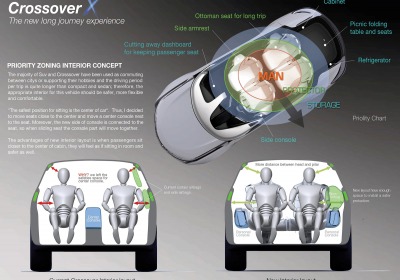Interior Motives Design Awards 2010
Fri, 01 Oct 2010As the doors closed to the press at the Mondial de L'Automobile in Paris, the world's top designers and automotive journalists gathered at the nearby Palais des Congrès d'Issy to watch a new generation of designers celebrate success at the 2010 Interior Motives Design Awards. Never before has the automotive industry been in greater need of fresh perspectives and innovation, and the students gathered here tonight provided both in spades - perhaps none more so than Kosin Voravattayagon of Sweden's Umeå Institute of Design, who walked away from the event with the Interior Motives Student Designer of the Year 2010 title and prize money totalling $5,000.
Themed ‘Driving the Interior Revolution', this year's contest attracted entries from an incredibly diverse range of schools and nationalities - from Israel and Iran, to Slovakia and South America. Created to satisfy the four briefs set by Volkswagen and Peugeot, the finalists' work displayed here in Paris had been nominated for awards in nine categories, as judged by our panel of influential senior designers. They watched with anticipation as host and renowned vehicle designer Peter Stevens revealed the results to a packed crowd.
This year's winners are:
Student Design of the Year (Presented by VW & Peugeot) & Best Production Interior (Presented by JCI)
'Crossover X' - Kosin Voravattayagon (Umeå Institute of Design, Sweden)
Voravattayagon's Crossover X secured victory in the hotly contested Best Production Interior category before going on to scoop the overall Student Design of the Year award. Described by Cadillac Interior Design Director Eric Clough as "beautiful, bold, sophisticated and harmonious", Crossover X was a major hit with the judging panel.
The concept draws heavily on Scandinavian design, emphasizing purity and simplicity in a four-seat interior whose overall form was inspired by glass works. The center console has been pushed to the outer edge of the seat frames, bringing occupants closer to the center to maximize passenger safety. Each individual console moves with the seat it's attached to, and the car's flat-floor packaging allows a large degree of interior flexibility; the front passenger seat folds and slides forward to provide an Ottoman-style rear chair, for example. Combined with an attractive and expertly conceived dashboard and superb execution throughout, it was enough to net its creator the top award in Paris. "Beautiful, believable and functional - a mature design that is still reaching conceptually," said Johnson Controls' Mike Warsaw.
Best Innovation (Peugeot)
'O3 concept' - Kaveh Nasserbakht & Ghazal Sarmast (Azad University of Tehran, Iran)
Described as a "simple and sympathetic" by Head of Citroën Interior Advanced Design, Andreas Stump, the O3 concept adapts the functionality of a camera lens to a commuter vehicle to generate an unparalleled level of flexibility. The tube-shaped body features telescopic sections that extend outwards from each side to create seating space for two additional passengers when needed; cleverly, the seats slide out from a stacking area below the driver's chair. Ford's Moray Callum called it a "beautifully simple exterior with lots of character, and an original and inventive way to offer flexible seating and expanding space." As he points out, in this case "less is more".
Best Use of Materials (Seton)
‘Urban Cruiser' - Michal Kukucka (Bratislava Academy of Fine Arts and Design, Slovakia)
Aimed at 25 to 30-year-olds that engage in sporting activities outside the city, the Urban Cruiser concept applies motorcycle design principles to a tandem-style, two-seater buggy. The vehicle is constructed from aluminum foam and flexible battery cells that function as part of the structure and self-cool from exposure to the air. Unusually, deceleration is applied by a ‘wind-powered braking system' that employs a series of airscrews to slow the vehicle at the same time as generating energy, while the HMI comprises a foldout smartbook that attaches to the center of the steering wheel. In the words of PSA Peugeot Citroën China design chief Double Du, "it unites wonderfully both form and performance, creating a complete and compelling portrait of a future lifestyle vehicle".
Best Lifestyle Interior (Car Design News)
‘TAV' - Nir Siegel (Shenkar College of Engineering and Design, Israel)
Another inventive take on urban mobility, Siegel's TAV concept proposes a shared system of personal ‘taxis' that can be driven away from collection points throughout the city, thereby creating a bridge between public and personal transport. Casting aside unnecessary functions, it provides an open interior with wipe-clean, wood laminate seating for up to four people - the driver sits in the center; passengers on bench-like interior surfaces - whose aesthetics and functionality are inspired by public spaces and urban architecture; the elevated glass canopy, for example, resembles the roof of a bus shelter, and retracts when not in use. Volkswagen's Potsdam interiors chief Romulus Rost described TAV as "a great idea for a car sharing system, exhibiting a good mix of visualization and smart systems".
Continues →
By Euan Sey

